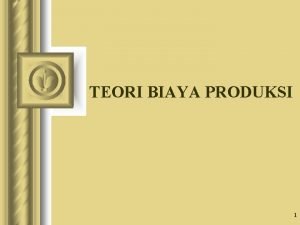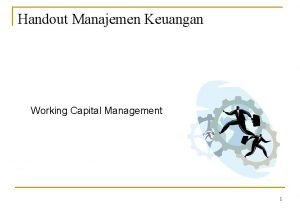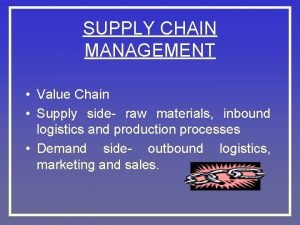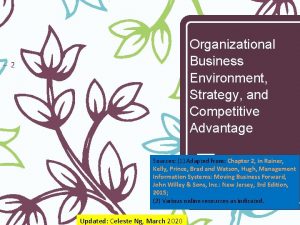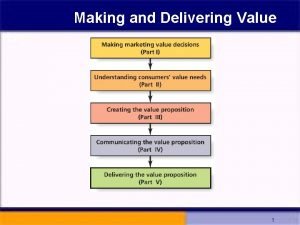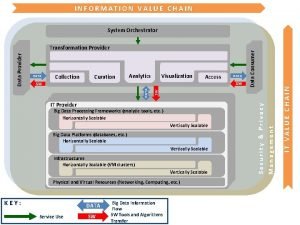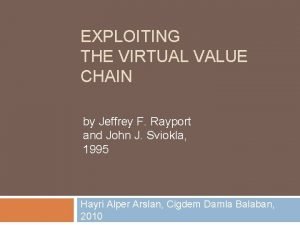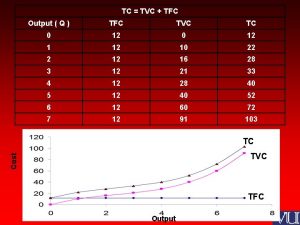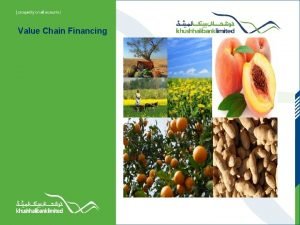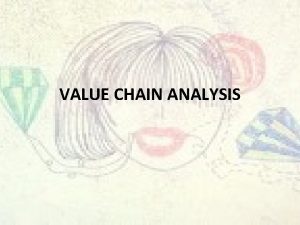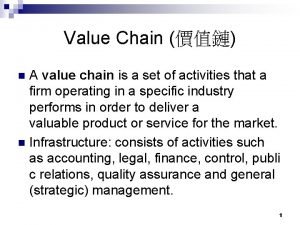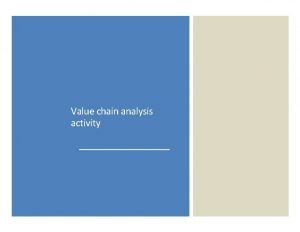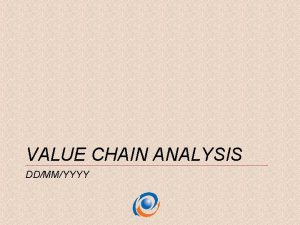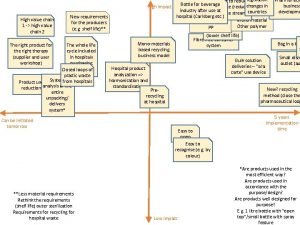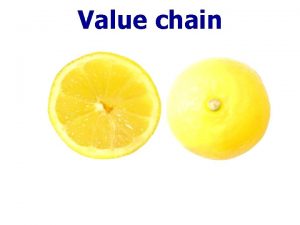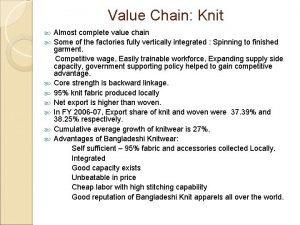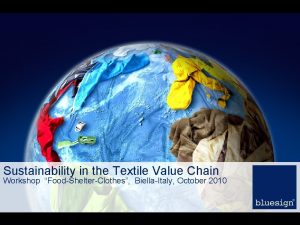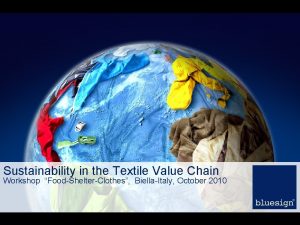TEXTILE POLICY TEXTILE VALUE CHAIN TVC 2020 25




















- Slides: 20

TEXTILE POLICY TEXTILE VALUE CHAIN (TVC) 2020 -25 TASKFORCE ON TEXTILES Shahid Sattar Executive Director APTMA Former Member Energy, Planning Commission

TEXTILE VALUE CHAIN § Pakistan is one of the few countries having a complete textile value chain – FARM TO FASHION § Textile Sector is the biggest employment generator- especially Garments. § $1. 5 / kg cotton can be converted up to $25 / kg product. 2

TEXTILE VALUE CHAIN 3

STRUCTURE OF APPAREL/GARMENT GVC 4

Pakistan (Tons/Hectare) World’s Best (Tons/Hectare) Pakistan as a percentage of best Wheat 3. 1 8. 1 (France) 38% Cotton 2. 5 4. 8 (China) 52% Sugar Cane 63. 4 125. 1 (Egypt) 51% Maize 4. 6 11. 1 (France) 41% Rice 2. 7 9. 2 (USA) 29% Crop AGRICULTURAL PRODUCTIVITY Source: Pakistan Business Council (PBC) * As a result, the cost of production of cotton in Pakistan is more than the double of world average. 5

q Decreasing profitability of cotton q Poor planting seed q Poor research support for farmers q Major insect problems (resistant pink bollworm, whitefly) q. Unmanaged access to once in a life-time transgenic cotton PROBLEMS technologies (ad hoc adoption → resistance q Water - delivery to farm & drainage/storages on farm q Climate change - heat tolerant cottons q Rural labor issues - machine pickable cottons q Insecticide resistance monitoring & management q Climate change - more weather stations required, untimely late rains q Outdated ginning technologies 6 q HVI testing - different labs give different results

2019 -20 2018 -19 2017 -18 2016 -17 2015 -16 2014 -15 2013 -14 2012 -13 2011 -12 COUNTRY/ PROVINCE % Change 2011 -20 COTTON AREA (million hectares) COTTON AREA, RAW PRODUCTION & YIELD MATERIALS Cotton PAKISTAN 2. 86 2. 88 2. 80 2. 89 2. 86 2. 41 2. 70 2. 68 2. 51 -12% PUNJAB 2. 53 2. 31 2. 22 2. 32 2. 24 1. 77 2. 53 2. 29 1. 86 -27% SINDH 0. 26 0. 53 0. 57 0. 63 0. 62 0. 63 0. 61 0. 39 0. 65 150% COTTON PRODUCTION (million bales) PAKISTAN 13. 60 13. 03 12. 77 14. 86 9. 77 10. 73 11. 94 10. 84 8. 57 -37% PUNJAB 11. 13 9. 52 9. 15 10. 90 6. 00 6. 94 8. 07 5. 09 -54% SINDH 2. 36 3. 40 3. 52 3. 98 3. 77 3. 79 3. 87 2. 60 3. 47 47% COTTON YIELD (Kgs. per hectare) PAKISTAN 815 769 774 782 508 756 752 687 580 -29% 747 701 707 712 421 664 669 600 466 -38% 1, 546 1, 090 1, 055 1, 064 939 1, 012 1, 049 1, 122 904 -42% PUNJAB 77 SINDH SOURCE: TCO/PCCC/PBS

Country China India Pakistan GLOBAL COTTON YIELD GROWTH 2011 -12 1, 345 518 815 % Change 34% 5% -29% Source: USDA, PCCC Just through Yield catch up with China; Pakistan’s production will go up to 26 million bales. GLOBAL COTTON YIELD GROWTH 8 Yield Kg/hec 2019 -20 1, 800 542 580

45. 00 600 566 554 40. 00 524 542 504 Approval of transgenic Bt cotton 35. 00 30. 00 INDIA - TECHNOLOGICAL INNOVATIONS IN COTTON 500 400 25. 00 Beginning of hybrid cotton era 308 267 20. 00 302 300 278 15. 00 200 134 10. 00 151 169 127 99 100 5. 00 - 9 0 1950 -51 1960 -61 1970 -71 1971 -72 1980 -81 1990 -91 2000 -01 2001 -02 2002 -03 2007 -08 2008 -09 2013 -14 2016 -17 2017 -18 Area In Million hectares Yield kgs per hectare Production In Million bales (170 Kgs)

INIATIVES TO ENHANCE PRODUTION & YIELD § Improve seed quality § Introduce latest farming and picking practices § Reduce contamination and improve cotton quality COTTON § Production of long staple cotton; resulting minimal reliance on imported cotton and enhanced overall exports It is essential to increase the cotton production / availability from 8. 6 Million Bales to 20 Million bales within 5 years 10

MMF - GLOBAL TRENDS § World trade is rapidly shifting from cotton to manmade fibres § Globally, use of man-made / synthetic fibres against natural fibres has shifted to a ratio of 70: 30, with synthetic fibres having the main share MAN MADE FIBRES (MMF) FILAMENT FIBRES 11 § Pakistan’s consumption ratio of MMF to cotton is 30: 70 § Currently there is 7% customs duty on the import of polyester staple fibre with total import expenses ranging up to 20% including antidumping duty § Pakistan should shift focus from cotton to Man Made Fibres (MMF) and target fibre mix of 50: 50

SOCIO-ECONOMIC SIGNIFICANCE OF TEXTILE INDUSTRY 12

GLOBAL TEXTILE EXPORTS - 2018 ($ BILLION) $350 $302 $300 $227 $250 $200 $150 $99 $100 $42 $50 $25 $25 $13 $14 s th er O a So ut h Ko re an ki st Pa U SA ng Ko H on g Tu rk ey de sh Ba ng la tn am Vi e In di a ro pe an U C hi ni na on $0 Presently, Pakistan’s Share is only 1. 6% in the global textile trade. Eu GLOBAL TEXTILE TRADE $33 Global market for textile exports is dominated by China, having 32% share of textile exports that amounts to $ 302 billion. TEXTILE EXPORTS 40 In Billion Dollars Pakistan’s Share in Global Textile Trade TEXTILE EXPORTS ($ Billion) 45 Growth (2009 -18) Value (2018 -19) China 65% 302. 42 20 Bangladesh 201% 40. 96 15 India 69% 37. 12 Vietnam 252% 36. 68 Pakistan 41% 13. 57 Cambodia 434% 13. 1 Countries 35 30 25 10 5 0 2002 13 BANGLADESH 2007 COMBODIA 2012 INDIA 2017 PAKISTAN VIETNAM

Strengths STRENGTHS & OPPORTUNITIES • Complete Textile Value Chain • Technical & Entrepreneurial Expertise • Compliant Factories • Young Labor Force • Captive Energy Generation Opportunities • CPEC Investment Corridor • Regional Textile Production. Consumption Hub • FTA 2 nd phase with China • EU GSP+ until 2023 • Growing Domestic Market External Challenges Internal Challenges INTERNAL & EXTERNAL CHALLENGES • • • 14 Energy affordability Current account deficit Shortage of raw materials Credit availability Lack of institutional support Infrastructural constraints (Integrated Textile Parks) Common influent treatment plants Skill development institutes Volatile exchange rate • • • Perception Management Market Access/ ASEAN, USA, Japan, Australia GSP plus status continuation Sustainable Supply Chain BCI Cotton ZDHC Carbon /water foot prints reduction Social standards compliance Compliances linked with SDGs & WTO rules

Articles of Apparel and Clothing Accessories is the leading textile export USD 452. 4 Billion Articles of apparel and clothing. . . 227. 1 Articles of apparel and clothing. . . 225. 3 Other made-up textile articles; set. . . TEXTILE & CLOTHING PRODUCTS TRADE 15 63. 5 Cotton 56. 9 Man-made filaments; strip and the. . . 46. 7 Man-made staple fibres 36. 1 Knitted or crocheted fabrics 35. 1 Wadding, felt and nonwovens; . . . 25. 3 Impregnated, covered or. . . 25. 2 Carpets and other textile floor. . . 15. 9 Wool, fine or coarse animal hair; . . . 13. 2 Special woven fabrics; tufted texti. . . 12. 4 Other vegetable textile fibres; pap. . . 4. 3 Silk 2. 1

EU and USA are the largest markets of textile of USD 373 Billion EU 28 258. 6 USA TOP TEXTILE & CLOTHING MARKETS 16 114. 1 Japan 35. 1 United Kingdom 31. 9 China 31. 1 Hong Kong 18. 8 Vietnam 17. 7 South Korea 14. 5 Canada 13. 9

China (33%) is the leading exporter of textiles in World followed by India (4. 7%) & Bangladesh (4. 6%). Pakistan’s share is only 1. 7% India 37. 2 Bangladesh 37. 0 Germany TEXTILE EXPORTING PLAYERS 35. 8 Italy 33. 9 Vietnam 31. 7 Turkey 26. 8 USA 25. 9 Hong Kong 21. 3 Spain 18. 6 France 15. 8 Belgium 17 15. 0 Netherlands 13. 3 South Korea 13. 3 Pakistan 13. 0 Indonesia 12. 5 China Textile Export USD 257 Billion 33% of World Textile Exports

Pakistan’s Apparel exports have grown at a slower rate than regional average APPAREL EXPORTING PLAYER AND GROWTH TRAJECTORY 18

Raw Materials • Vertical & Horizontal increase in production of cotton. • Provide Polyester Staple Fiber without incidentals, duties & taxes. Energy • Long term uniform & internationally competitive energy prices across the country for exporting industry Liquidity • Liquidate all textile Industry refunds of sale tax, income tax, policy & package initiatives. Provide ERF to all exports including yarn & greige fabric. ENABLERS 19 • Investment • Allow LTFF to indirect exports & enhance credit limit for investment under LTFF to Rs. 3 billion per project. • Industrial Credit allocation policy of SBP be reintroduced. • Fast Track establishment of Integrated Textile & Apparel Parks enabling plug & play facilities for local and foreign investors. • Special task force on revival of closed mills. Market • Market Promotion measures for attracting international brands and retail chains of Europe & USA. • Drawback of local taxes & levies to zero rate export (long term schemes). Long Term Textile Policy • Most importantly a Long Term Textile Policy

THANK YOU
 Tvc hazlewood
Tvc hazlewood Teori biaya produksi
Teori biaya produksi Mengelola keuangan
Mengelola keuangan Vertical distance between atc and avc
Vertical distance between atc and avc Sequence of food chain
Sequence of food chain What is logistics management
What is logistics management Apa itu value creation
Apa itu value creation Claim of policy examples
Claim of policy examples Claims of values
Claims of values Claim of fact value and policy examples
Claim of fact value and policy examples Example of a claim of value
Example of a claim of value Corporate financial policy and the value of cash
Corporate financial policy and the value of cash Okc ckc
Okc ckc Value chain structure
Value chain structure Porter value chain
Porter value chain Porter's value chain model
Porter's value chain model Generic value chain
Generic value chain Value chain visualization
Value chain visualization Heineken case study
Heineken case study Physical value chain
Physical value chain Value chain analysis of coconut in the philippines
Value chain analysis of coconut in the philippines

